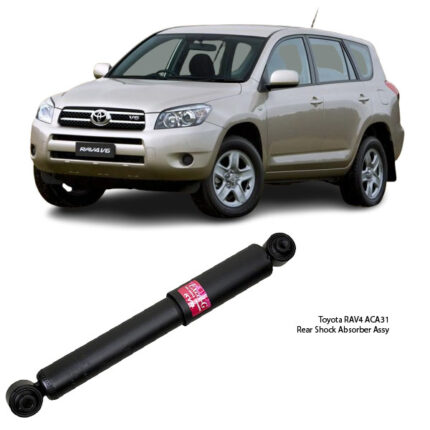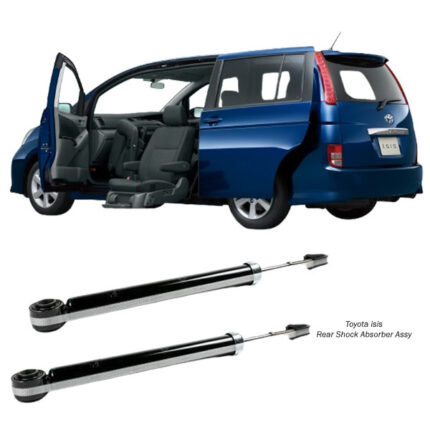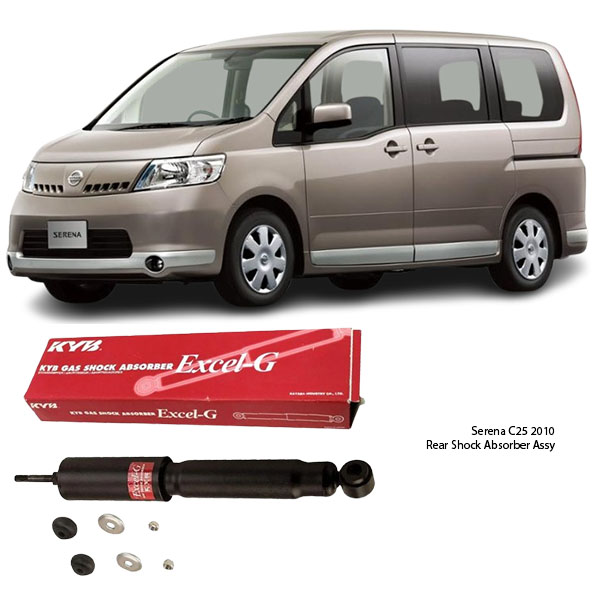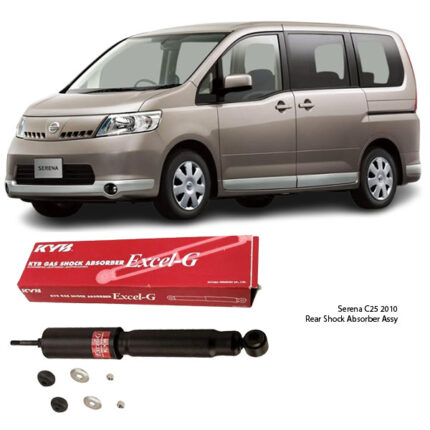Get Nissan Serena Rear Shock Absorber RH/LH 348077 in Kenya
The rear shock absorbers on your vehicle play a crucial role in ensuring a smooth, stable, and controlled ride. Whether you’re navigating city streets, highways, or off-road trails, properly functioning rear shock absorbers (RH – Right-Hand / LH – Left-Hand) help absorb impacts, maintain traction, and enhance overall driving safety.
This guide will provide a detailed overview of rear shock absorbers, their functions, types, signs of wear, replacement process, and why they are essential for your vehicle’s suspension system.
What is a Rear Shock Absorber?
A rear shock absorber is a component of the vehicle’s suspension system designed to dampen vibrations, control bouncing, and absorb road impacts. Located at the rear right (RH) and rear left (LH) sides, these shocks ensure that the wheels remain in constant contact with the road for better stability and handling.
RH (Right-Hand) Rear Shock Absorber – Installed on the right side of the rear axle.
LH (Left-Hand) Rear Shock Absorber – Installed on the left side of the rear axle.
Both RH and LH shocks work together to provide even weight distribution, prevent excessive vehicle swaying, and improve braking efficiency.
Functions of Rear Shock Absorbers
Rear shock absorbers are responsible for maintaining ride comfort, handling, and vehicle safety. Here’s how they work:
Absorbs Road Shocks & Vibrations
- Reduces the impact of bumps, potholes, and uneven surfaces.
- Prevents excessive bouncing of the rear wheels.
Enhances Vehicle Stability & Control
- Keeps the vehicle from swaying or rolling excessively when turning.
- Improves traction by keeping the tires firmly on the ground.
Supports Braking Performance
- Prevents the rear of the car from lifting excessively during braking.
- Helps distribute braking force evenly.
Reduces Tire Wear & Suspension Stress
- Prevents uneven tire wear caused by excessive bouncing.
- Minimizes stress on other suspension components.
Improves Passenger Comfort
- Absorbs road vibrations for a smoother and quieter ride.
- Reduces discomfort when driving over rough terrain.
Types of Rear Shock Absorbers
Rear shock absorbers come in different types, designed for various driving needs.
Hydraulic (Oil-Filled) Shock Absorbers
Uses hydraulic fluid to absorb shocks.
Provides a smooth and comfortable ride.
Can overheat under extreme conditions.
Gas-Filled (Gas-Charged) Shock Absorbers
Uses nitrogen gas to prevent hydraulic fluid foaming.
Enhances stability, making it ideal for high-speed driving.
Slightly stiffer ride compared to hydraulic shocks.
Twin-Tube Shock Absorbers
Features two chambers – one for oil and another for gas.
Affordable and commonly used in standard vehicles.
Less effective at dissipating heat than monotube shocks.
Monotube Shock Absorbers
Uses a single tube design for improved heat dissipation.
Ideal for sports cars and off-road vehicles.
More expensive than twin-tube shocks.
Adjustable Shock Absorbers
Allows manual or electronic adjustment for different driving conditions.
Used in high-performance vehicles and off-road setups.
Requires tuning for optimal performance.
Signs of a Failing Rear Shock Absorber
Over time, rear shock absorbers wear out due to constant exposure to road conditions. Here are the warning signs:
Excessive Bouncing
If your vehicle bounces multiple times after hitting a bump, the shocks are no longer absorbing impacts properly.
Unstable Handling & Body Roll
If your car feels unstable, leans excessively in turns, or sways too much, your rear shocks may be worn out.
Uneven Tire Wear
Worn shocks cause cupping or scalloping on the rear tires, leading to premature replacement.
Oil Leaks on the Shock Absorbers
Visible fluid leaks indicate that the shock’s internal seals are failing.
Strange Noises from the Rear Suspension
Clunking, rattling, or knocking sounds when driving over bumps suggest worn-out shocks.
Rear End Squatting
If the rear of your car sags excessively when carrying passengers or cargo, your shocks may be failing.
Longer Braking Distance
Bad shocks reduce tire grip, leading to longer stopping distances.
Ignoring failing rear shocks can lead to dangerous driving conditions!
How to Replace Rear Shock Absorbers RH/LH
Replacing rear shock absorbers is a moderate difficulty DIY task. However, a mechanic can perform the job quickly if you prefer professional service.
Tools & Equipment Needed
Jack & Jack Stands
Lug Wrench
Socket Set & Ratchet
Torque Wrench
Penetrating Oil (for rusted bolts)
New Rear Shock Absorbers (RH & LH)
Step-by-Step Replacement Process
Secure the Vehicle & Lift the Rear End
- Park on a level surface and apply the handbrake.
- Use wheel chocks to prevent rolling.
- Loosen the rear wheel lug nuts before lifting.
- Jack up the rear of the vehicle and support it with jack stands.
Remove the Rear Wheels & Old Shock Absorbers
- Remove the wheels for easier access.
- Locate the upper and lower shock mounting bolts.
- Use penetrating oil if bolts are rusted.
- Remove the shock absorber carefully.
Install the New Rear Shock Absorbers
- Position the new shock absorber in place.
- Secure with upper and lower mounting bolts.
- Torque the bolts to manufacturer specifications.
Reinstall the Wheels & Lower the Vehicle
- Mount the wheels back onto the vehicle.
- Lower the car carefully and tighten the lug nuts properly.
Test Drive & Check for Issues
- Drive over bumps to test ride quality.
- Listen for unusual noises and ensure smooth suspension operation.
Follow us on Facebook for more parts.




